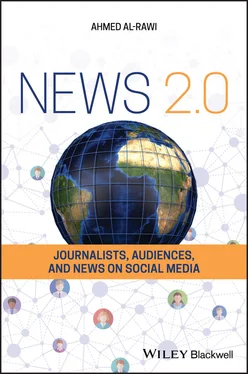In terms of future news research, there are promising opportunities. Mobile news apps are still highly under‐researched, especially the means by which audiences interact among themselves in a high‐tech version of the comments section. Also, there are many digital tools and online platforms that can be better utilized by researchers for the future study of news. For instance, Facebook Ads Manager is an interesting platform that can be employed to understand the demographics of Facebook news production and dissemination. It can provide detail on international audiences' consumption of news along different variables, including gender, age, geographical location, educational level, ethnicity, interests, and so forth. This tool has recently been employed in many different studies to identify audiences' interests regarding a variety of issues, such as news bias, disease surveillance, migrant monitoring, gender gaps, and schizophrenia awareness, among other things (Araujo et al. 2017; Saha et al. 2017; Zagheni et al. 2017; Fatehkia et al. 2018; Ribeiro et al. 2018). For example, there are 6.7 million users on Facebook, aged from 18 to over 65, who show interest or engagement with the following media outlets: the Globe and Mail , ABC News, CNBC, the New York Times , the Washington Post , the Canadian Broadcasting Corporation, BBC News, CTV Television Network, CBS News, the Washington Times , CNN, Fox Broadcasting Company, NBC, and the Wall Street Journal . To give another example, there are over 13 million people worldwide interested in the Fox News channel, including 6.8 million males and 6.8 million females aged between 18 and over 65. Geographically, there are 110 000 users in the United Kingdom, 67 000 in Australia, and 140 000 in Canada interested in this news channel.
There are many other avenues opening up for future research. The GDELT Project, a global media‐monitoring database associated with Google Jigsaw, offers some interesting areas of news research, though there are limitations in terms of its thematic and visual classification of news stories. It can be used to examine and test several theories and concepts related to news values, biases, agenda setting, and intermedia agenda setting.
1 Abdul‐Mageed, M. (2008). Online news sites and journalism 2.0: reader comments on Al‐Jazeera Arabic. tripleC: Communication, Capitalism & Critique 6: 59–76.
2 Al‐Rawi, A. (2016a). Assessing public sentiments and news preferences on Al Jazeera and Al Arabiya. International Communication Gazette 79 (1): 26–44.
3 Al‐Rawi, A. (2016b). Understanding the social media audiences of radio stations. Journal of Radio & Audio Media 23 (1): 50–67.
4 Al‐Rawi, A., Groshek, J., and Zhang, L. (2019). What the fake? Assessing the extent of networked political spamming and bots in the propagation of #fakenews on Twitter. Online Information Review 43 (1): 53–71.
5 Anderson, C.W. (2011). Between creative and quantified audiences: Web metrics and changing patterns of newswork in local US newsrooms. Journalism 12 (5): 550–566.
6 André, P., Bernstein, M., and Luther, K. (2012). Who gives a tweet?: Evaluating microblog content value. In: Proceedings of the ACM 2012 Conference on Computer Supported Cooperative Work. ACM.
7 Araujo, M., Mejova, Y., Weber, I., and Benevenuto, F. (2017). Using Facebook ads audiences for global lifestyle disease surveillance: promises and limitations. In: Proceedings of the 2017 ACM on Web Science Conference, pp. 253–257. ACM, June.
8 Boczkowski, P. (1999). Understanding the development of online newspapers. New Media & Society 1 (1): 101–126.
9 Braun, J. and Gillespie, T. (2011). Hosting the public discourse, hosting the public: when online news and social media converge. Journalism Practice 5 (4): 383–398.
10 Bright, J. and Nicholls, T. (2014). The life and death of political news: measuring the impact of the audience agenda using online data. Social Science Computer Review 32 (2): 170–181.
11 Bruns, A. (2007). Produsage: towards a broader framework for user‐led content creation. In: Proceedings of the 6th SIGCHI Conference on Creativity & Cognition. ACM, Washington, DC, June 13–15.
12 Castells, M. (2011). The Rise of the Network Society, vol. 12. New York: Wiley.
13 Chung, D.S. (2008). Interactive features of online newspapers: identifying patterns and predicting use of engaged readers. Journal of Computer‐Mediated Communication 13 (3): 658–679.
14 Chung, D.S. and Yoo, C.Y. (2008). Audience motivations for using interactive features: distinguishing use of different types of interactivity on an online newspaper. Mass Communication and Society 11 (4): 375–397.
15 Constantinescu, A.R. and Tedesco, J.C. (2007). Framing a kidnapping: frame convergence between online newspaper coverage and reader discussion posts about three kidnapped Romanian journalists. Journalism Studies 8 (3): 444–464.
16 Dickson, E. (2014). Here's proof that nobody reads stories you post on Facebook. Available from: http://www.dailydot.com/lol/npr‐april‐fools(accessed November 28, 2019).
17 Emmett, A. (2009). Networking news: traditional news outlets turn to social networking Web sites in an effort to build their online audiences. American Journalism Review 30 (6).
18 Evans, P. (2015). Facebook's Instant Articles service launches with 9 major Web publishers. CBC News. Available from: https://www.cbc.ca/news/business/facebook‐s‐instant‐articles‐service‐launches‐with‐9‐major‐web‐publishers‐1.3072156(accessed November 28, 2019).
19 Facebook (2019). Help Center: how news feed works. Available from: https://www.facebook.com/help/327131014036297(accessed November 28, 2019).
20 Fatehkia, M., Kashyap, R., and Weber, I. (2018). Using Facebook ad data to track the global digital gender gap. World Development 107: 189–209.
21 Garcia, M.R., Stark, M.M., and Miller, E. (1991). Eyes on the news. Poyter Institute. Available from: http://www.poynter.org/tag/eyes‐on‐the‐news/(accessed November 28, 2019).
22 Garrison‐Sprenger, N. (2008). Twittery‐do‐dah, twittering pays. Quill 96: 12–15.
23 Goode, L. (2009). Social news, citizen journalism and democracy. New Media & Society 11 (8): 1287–1305.
24 Goodman, E. (2013). Online comment moderation: emerging best practices; a guide to promoting robust and civil online conversation. World Editors Forum. Available from: http://wan‐ifra.org/online_commenting_report(accessed November 28, 2019).
25 Gunaratne, S.A. (2010). De‐Westernizing communication/social science research: opportunities and limitations. Media, Culture & Society 32 (3): 473–500.
26 Hanitzsch, T. (2019). Journalism studies still needs to fix Western bias. Journalism 20 (1): 214–217.
27 Harcup, T. (2014). A Dictionary of Journalism. Oxford: Oxford University Press.
28 Harris, J. (2010). How often is the Times tweeted? New York Times. Available from: http://open.blogs.nytimes.com/2010/04/15/how‐often‐is‐the‐times‐tweeted/?_r=0(accessed November 28. 2019).
29 Hermida, A. (2010). Twittering the news: the emergence of ambient journalism. Journalism Practice 4 (3): 297–308.
30 Hermida, A. (2013). #Journalism: reconfiguring journalism research about Twitter, one tweet at a time. Digital Journalism 1 (3): 295–313.
31 Horan, T.J. (2013). “Soft” versus “hard” news on microblogging networks: semantic analysis of Twitter produsage. Information, Communication & Society 16 (1): 43–60.
32 Holmqvist, K., Holsanova, J., Barthelson, M., and Lundqvist, D. (2003). Reading or scanning? A study of newspaper and net paper reading. Mind 2 (4): 1–17.
33 Howell, D. (2007). Online venom or vibrant speech Washington Post. Available from: http://www.washingtonpost.com/wp‐dyn/content/article/2007/05/04/AR2007050401904.html(accessed November 28, 2019).
Читать дальше












